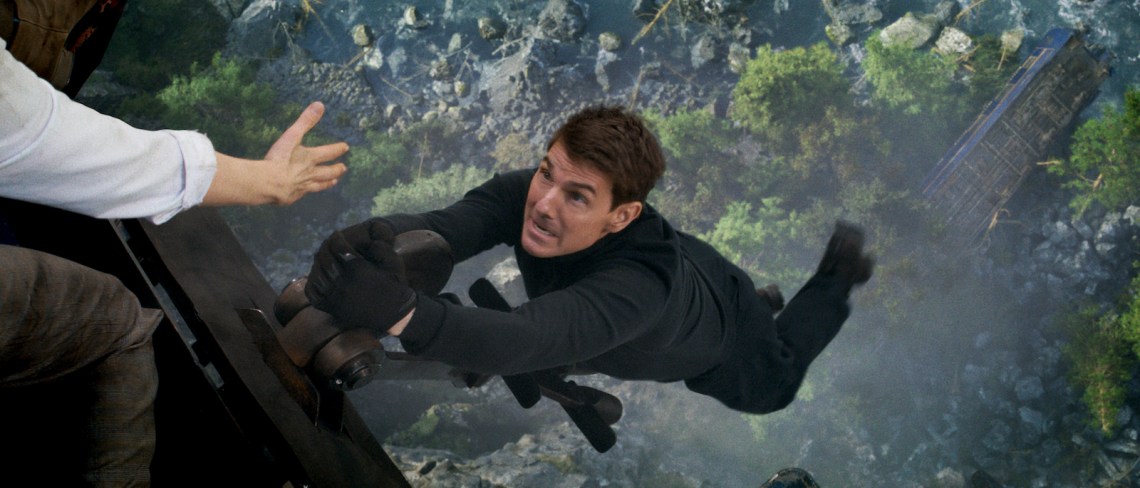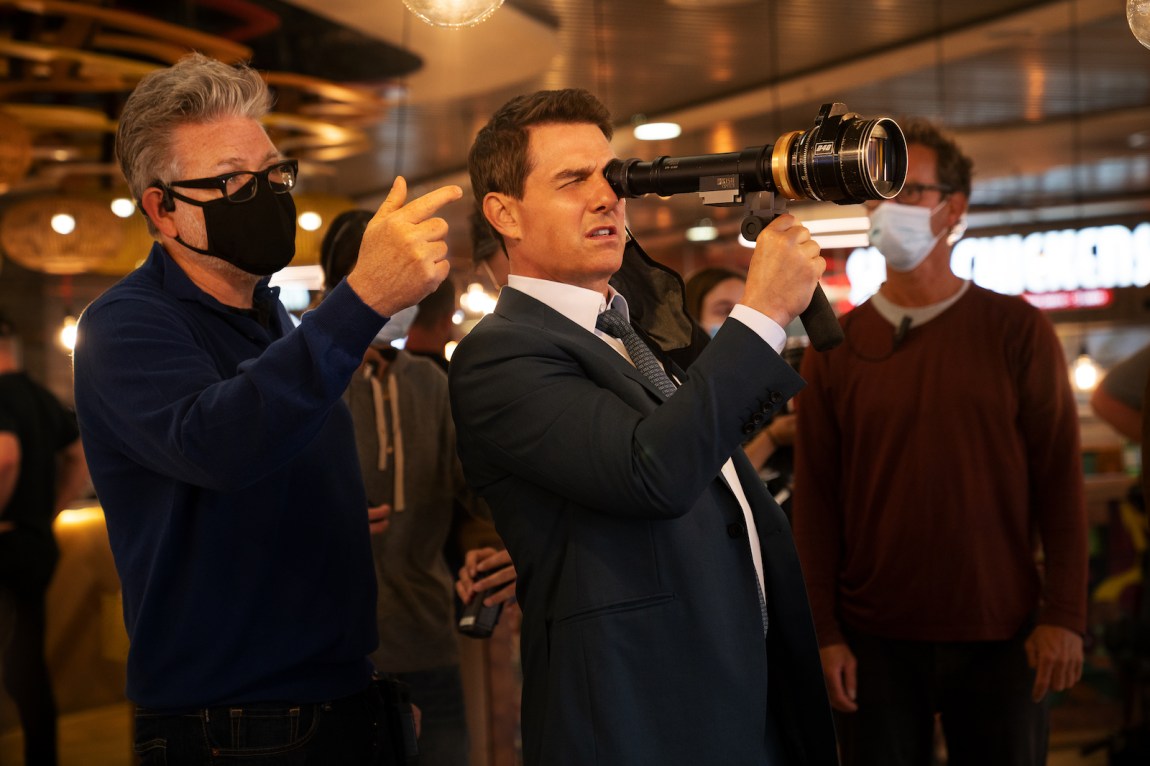At the end of August 2020, Tom Cruise was on a mission to prove it was safe to go back to the movies. Donning a black mask over his nose and mouth, the actor sped off to see Christopher Nolan’s Tenet as it opened in London. Such was the confusion of that summer in the film industry that even as Tenet debuted, Access Hollywood, the entertainment news TV show, pronounced the title of Nolan’s film “ten-AY,” to rhyme with bidet. “Back to the movies,” Cruise said as he entered the theater by himself, very low-key. A hundred and fifty minutes later, exiting up the stairs, he quietly answered “I loved it” to someone in the audience who asked what he thought. A perfectly timed stealth mission: Cruise swooped in and out. Theatrical film exhibition would not die on his watch.
But as watchers of his Mission: Impossible movies know, every action has an equal and opposite reaction. Four months later, on the set of Mission: Impossible–Dead Reckoning, Part One, then called simply Mission: Impossible 7, Cruise was caught on tape berating his crew for violating Covid protocols. “We are not shutting this fucking movie down!” he yelled. “If I see you do it again, you’re fucking gone…. No apologies. You can tell it to the people that are losing their fucking homes because our industry is shut down.” The recording was leaked to a British tabloid; quickly social media pointed out that the old Tom Cruise, the one notorious for manic rants during which he did things like mansplain Brooke Shields’s postpartum depression on The Today Show, was back.
Production on the new Mission: Impossible movie had been halted three times before Cruise’s outburst, while the release of his Top Gun sequel, Top Gun: Maverick, completed in 2019, had been postponed again and again. He was on edge, but as it turned out there was nothing to worry about. In a career that has been defined by the greatest luck and hardest work, these delays worked to his advantage. Finally released last summer, Maverick was an enormous hit. It has made $1.5 billion to date, and is credited—largely credited, as they say—with saving Hollywood from ruin.
Mission: Impossible–Dead Reckoning, Part One, also delayed about two years, came out this summer and nearly performed the same feat as Top Gun: Maverick did. It raked it in at the box office after a full year of non–Tom Cruise movies like The Flash tanked—bad movies that are part of bad cycles that have gotten worse, and which no longer make money. The new M:I movie emerges into what is arguably a more perilous time for Hollywood than the pandemic, with studios threatening to use artificial intelligence to replace writers and actors, whose unions have called strikes. This potential new digital blight is coupled with the cheapness of the studio bosses in the streaming era, who goosed their studios’ stock value during the pandemic and prefer to cut costs rather than share the wealth.
And yet nobody is going to thank Tom Cruise twice, not this year. As we wait until next summer or later for Part Two of Cruise’s multimillion dollar cliffhanger, production of which has been shut down by the Screen Actors Guild strike, mania for the binary of Greta Gerwig’s Barbie and Nolan’s Oppenheimer has gripped a world suddenly rich with quality non-superhero blockbuster success stories. Add to that the very unexpected smash breakout of another long-delayed movie, the right-wing action thriller Sound of Freedom, and suddenly the movies are back. They are so back it’s almost like they have returned to a time before the superhero apocalypse—that computer-generated miasma instrumental in training AI to take over—ground them into digital dust. In that era, Cruise was the last man standing. Now all of a sudden he is underperforming, despite his movie taking in more than $400 million worldwide so far.
*
Recently I saw the 1980 espionage thriller-comedy Hopscotch, starring Walter Matthau as a CIA agent fired for sticking to his old ways in an increasingly corporatized spy biz. Matthau was sixty when he made it, the same age as Tom Cruise when he was making Dead Reckoning. It goes without saying that these two quintessential American actor/movie stars have little in common. Cruise’s Ethan Hunt is all action, his emotions hidden, his skills surprising, his loyalty to his team and their mission limitless. He is the master of every machine and gadget. We are meant to understand that he can do anything. Matthau, by contrast, chooses to do almost nothing. He shows no loyalty, wears his disgruntlement on his sleeve, and chews scenery. Always old before his time, Matthau lingers in cafés going over notes, scheming to make his bosses look dumb.
Advertisement
Hopscotch includes the things Mission: Impossible movies leave out. We see Matthau haggling over safe house rentals and forged passport prices, buying clothes for his disguises, walking around empty fields as he silently plans. As for gadgets, he uses a paperclip to short out the lights in a police station, the paperclip being the one device Hopscotch shares with Dead Reckoning. There, Hayley Atwell, playing a thief, uses one to free herself from handcuffs, then uses them to attach Cruise to the steering wheel of a Fiat 500, which is trapped in a tunnel where it is of course about to be hit by an oncoming train.
Cruise at sixty still does his own stunts, which appear more dangerous and extreme with each of these movies, especially since he has teamed with the director-screenwriter Christopher McQuarrie, starting with the fifth in the series, Mission: Impossible—Rogue Nation (2015). Legitimately thrilling, their set pieces are nonstop inventive in the manner of can-you-top-this American know-how, returned to ultra-professional glory from the dirtbag daring of the Jackass movies, their natural competition (rather than The Flash). Matthau at sixty, on the other hand, knew one real test of cinematic greatness was the ability to sit there and do nothing and still hold the screen. We cannot picture Matthau at that age or at any age learning to hold his breath for nine minutes so he could do an underwater stunt in tactical gear holding a flashlight in his mouth.
It is hard to believe that when the first Mission: Impossible movie debuted in 1996, Cruise had already been a movie star for thirteen years. When Brian De Palma’s film version of the TV series came out with Cruise and Jon Voight, the actors from the original 1960s show complained. The movie was nihilistic, there were double agents in it, it wasn’t patriotic. These were strange objections from the stars of a series that featured extrajudicial assassinations, unofficial regime change, and state-sanctioned kidnappings.
In fact, the movie, post–cold war, kept the best parts of the show: the lifelike masks characters use to impersonate each other, allowing actors to play two parts with the same face, and the idea that espionage was a series of short or long cons more like theater acting and stage magic than diplomacy by other means.
De Palma also linked the franchise to cinema history in a way Cruise and McQuarrie have maintained, bringing the mise-en-scene and the mood all the way back through Hitchcock to German Expressionism via the silent crime and spy movies Fritz Lang made in the 1920s, Dr. Mabuse, the Gambler and Spione. Right away, in the first scene of De Palma’s film, a tense interrogation is deconstructed before our eyes as the walls of the set are moved aside or flattened to reveal an empty warehouse—the soundstage itself—while the actors peel off their faces, revealing nothing beneath them but the faces of other actors.
As in Hopscotch, but not in the TV series, the enemy in the Mission: Impossible movies is within. It is always a competing government spy agency that is stopping Cruise and his team from accomplishing the mission they have chosen to accept. Beneath the deep state is a deeper state still. Fittingly, as on the TV show, the news of these missions comes from a tape recorder that self-destructs, as if Cruise has found a stray Nagra on the set that instead of being used to record dialogue has been rigged to emit some smoke before the editor cuts away from it and the theme music starts to play. That music, by Lalo Schifrin, is the prime intellectual property in this series of films, in itself a reason to keep making them, and in its dot-dash intensity a spur to make them good.
*
Cruise’s employers are always disavowing him in these movies. He returns to work like Charlie Brown coming back to kick the nuclear football while Lucy holds it for him again. Dead Reckoning, despite its setbacks, has the lucky perspicacity to appear to be seeing into the future. The overarching conspiracy here has to do with a killer AI set to take over the world’s entire OS, forever blurring the line between reality and illusion, truth and lie. More than ever, the M:I films are about the nature of the film industry itself, and the way stories are told by actors—actors who seem to act as writers, writing the movie as they go along.
The AI, therefore, can take over spy systems and imitate a familiar voice (Simon Pegg’s), then say into Cruise’s earpiece, “Go left! No, go right! No, go left!” as he chases an assassin, in imitation of the directions in a screenplay or those given by a director on set. Of course the AI paints him into a corner—it exists to ruin his performance. In Dead Reckoning, both Cruise and the entire US surveillance apparatus have to go fully analog to fight their AI enemy, a narrative turn that both reaffirms the movie’s dedication to filming real stunts in front of the camera and presciently combats the studio bosses’ insistence on a new filmmaking world of computer-generated screenplays and performances along with special effects.
Advertisement
One of the most admirable lines in the movie comes after Atwell’s character asks Cruise and his team why they are willing to help her, since they don’t even know her. “What difference does that make?” he asks, a fading echo of Hawksian professionalism and humanism in this globalized landscape, part of this film series’ (and Cruise’s) anti-psychological approach, where backstory always struggles to be buried and forgotten, and usually is. It’s the opposite of the maudlin nonsense about family in the Fast & Furious movies.
It is hard to ignore that Cruise has looked a little tired during the extensive, international press tour for Dead Reckoning. Visibly older than when he went to see Tenet in London three years ago, he nonetheless exudes a kind of perplexed, patient bonhomie as he travels the world to sell his film, his slightly disconnected, mechanized mien and tense bearing now newly patient, an aura that envelops the entire category “movie star.” In cinemas, before the film starts, a very short clip of Cruise and McQuarrie plays in which the star-producer and writer-director thank the audience for seeing their movie in a theater, where they made it to be seen. McQuarrie, gray-haired and gray-bearded, gets to look his age; Cruise is locked in, in more ways than one.
With the temporary shutdown of Dead Reckoning, Part Two, Cruise is once again stuck in the quagmire of twenty-first-century studio filmmaking, where every crisis resolves in stasis. Will there come a time for him when that kind of entropy beats his luck and hard work? So much went wrong in making Part One. When the young British actor Nicholas Hoult, slated to play the film’s principal villain, dropped out, Cruise and McQuarrie or someone got the idea to replace him with the journeyman trouper Esai Morales. What luck that the most calm, cool, and collected character in the movie, and the best-looking and most evil, just happens to be a man for today—a pro-union Puerto Rican TV actor from Brooklyn the exact same age as Cruise. On such accidental genius the Hollywood cinema survives another year.





